
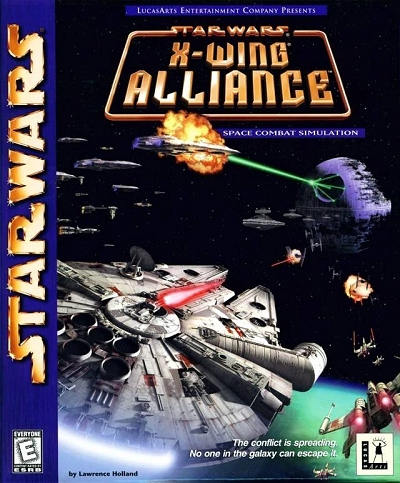
A thesis that endeavors to analyze, correct, and translate the game assets of the “Star Wars® X-Wing Alliance” PC Game into the game statistics of The Star Wars® Roleplaying Game published by West End Games®. Thesis compiled, written, and edited by Frank V Bonura with help from: Charles McNeill, Chris Curtis, Dean Magill, the membership of The Rancor Pit Forum, Paul Cargile, and the membership of the Star Wars® Deckplans Alliance.
I would like to extend special thanks to the team at X-Wing Alliance Upgrade whose help, in understanding the programming of the PC game, and the MXvTED and OPTech software that made this project possible.
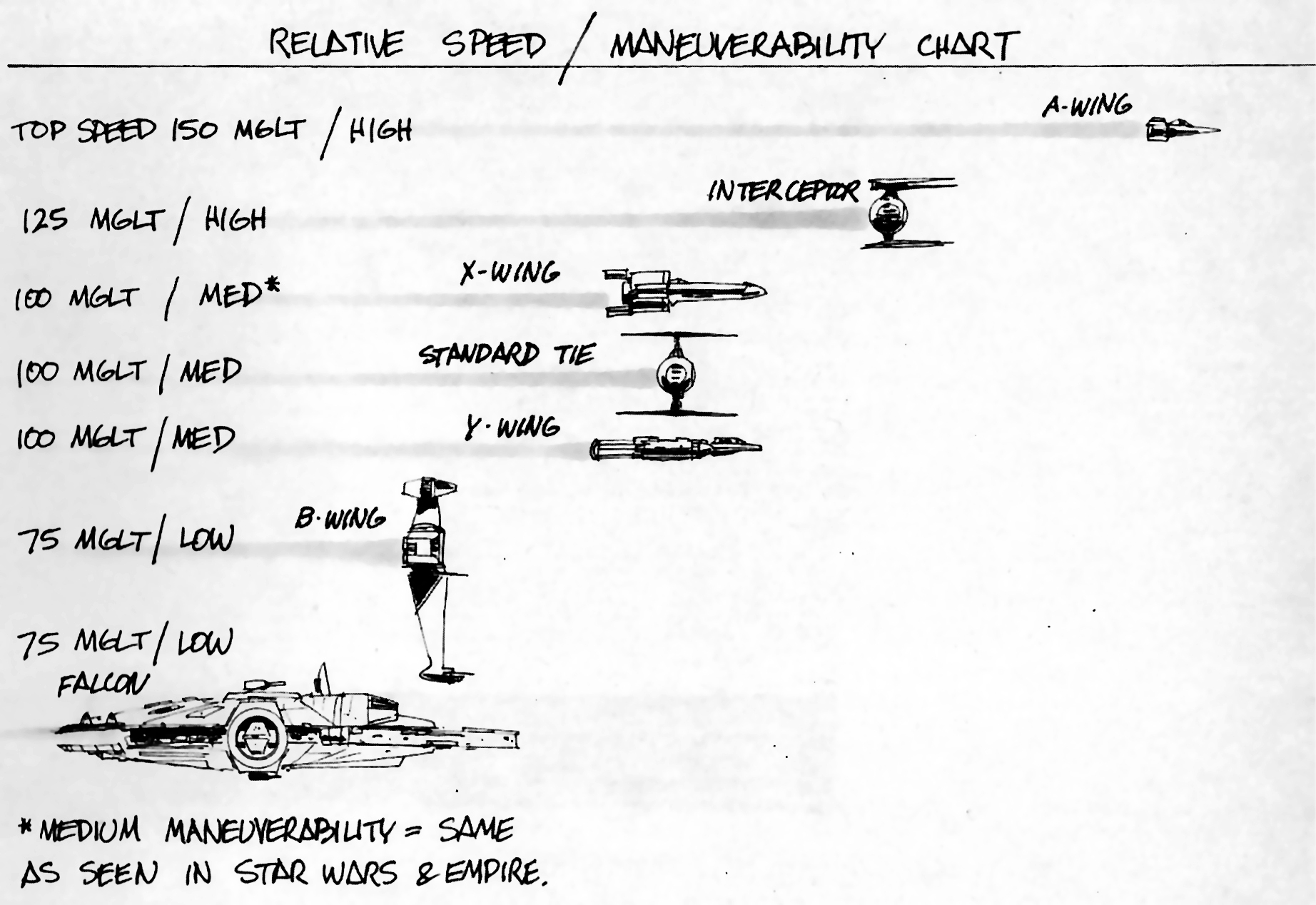
Fig. 1 — Relative Speed / Maneuverability Chart, artwork by: Joe Johnston,
“Return of the Jedi Sketchbook”, page 95 (c. January 1, 1983)
The oldest source of starfighter performance data comes from the Relative Speed / Maneuverability Chart from the production of “Return of the Jedi”. It is believed these specifications were for the motion control cameras to simulate starfighter movement in the movies. By moving the camera a specific distance and angle, per frame, different flight characteristics could be achieved prior to the adoption of computer graphic imagery. The chart makes comparisons to the flight characteristics in “Star Wars” (A New Hope), and “The Empire Strikes Back”. It should be noted the TIE Bomber from “The Empire Strikes Back” was not included on this chart. The effects of this omission will be addressed later in this thesis.
You will note the flight characteristics of the X-Wing, Standard TIE Fighter, and Y-wing are all the same. The A-wing, and TIE Interceptor share the same maneuverability and are the two fastest ships on the chart. Lastly the Millennium Falcon, and the B-wing share the same flight characteristics being the slowest, least-maneuverable on the chart. From these specifications we can quantify relative metrics for computer, tabletop, and roleplaying games.

Fig. 2 Spacecraft Performance Data Chart, “Star Wars® Sourcebook”, first Edition, page 23 (c. November 1987)
The oldest source of compiled starfighter data for the roleplaying game comes from the Spacecraft Performance Data Chart in the first edition of the “Star Wars® Sourcebook”. You will note here the maneuverability of the X-Wing, Y-wing, and the Standard TIE Fighter (TIE/ln) are not the same as they were depicted in the Relative Speed / Maneuverability Chart (see Fig. 1). The sublight speed of the Y-wing is now slower than the X-Wing, and the Standard TIE Fighter (TIE/ln) is faster than both.
Likewise the maneuverability of the A-wing was improved to be slightly better than the TIE Interceptor, and the sublight speeds were kept mostly the same. The Millennium Falcon is now slightly less maneuverable but faster than the B-wing. The exact reason for these changes from the original motion control resources are unknown. These deviations from the original source may have been the result of early playtesting, and an attempt to make the roleplaying game easier and more survivable for the Player during starfighter combat.
In the PC games, changes to power distribution between engines, shields, and weapons, affect the performance of starfighters with shields that have surplus power to distribute to different systems. TIE Fighters differ in power distribution as follows:
“TIE/ln Now the standard fleet-based TIE fighter, this model carries a separate power generator for its laser cannons.”
— Bill Slavicsek and Curtis Smith,“Star Wars® Sourcebook”,
first Edition, page 23 (c. November 1987)
In October of 1992 the Second Edition of Star Wars®, The Roleplaying Game was published and the rules for play were changed for movement from the more abstract D6 mechanic (see Fig. 2) to a static distance per combat round mechanic. The new movement rules now provide for separate rates of speed for space flight, in hard vacuum, and atmosphere.
Listed below are all the comparable statistics for starfighters that have contemporaries in the “X-Wing Alliance” PC Game.
| Ship Type | Space Speed | Atmosphere Speed | Maneu- verability | Hull | Shield Rating | Source |
|---|---|---|---|---|---|---|
| A-wing Starfighter | 12 | 450; 1,300 km/h | 4D | 2D+2 | 1D | Star Wars SB, 2nd Ed, p. 16 |
| Assault Gunboat | 8 | 365; 1,050 km/h | 2D | 4D+1 | 2D+2 | Star Wars AJ, No. 15, pp. 81-82 |
| Authority IRD-Aa | 9 | 400; 1,150 km/h | 2D+1b | 4D | 1Dc | Han Solo & the CSA SB, p. 103 |
| B-wing Starfighter | 6d | 330; 950 km/hd | 1D+1 | 3De | 2D | Star Wars SB, 2nd Ed, p. 17 |
| CloakShape Fighter | 6f | 330; 950 km/hf | 1D+1g | 4D+2 | 1Dh | Dark Empire Sourcebook, p. 106 |
| Firespray-class | 5i | 295; 850 km/hi | 1Dj | 4D | 1D | Pirates & Privateers, p. 75 |
| Preybird Fighter | 9 | 400; 1,150 km/h | 2Dk | 3D+2 | 2D | The Far Orbit Project, p. 96 |
| Pursuer Enforcement | 7l | 350; 1,000 km/hl | 1Dm | 4D | 1Dn | Pirates & Privateers, p. 75 |
| Skipray Blastboat | 8 | 415; 1,200 km/ho | 1D+2p | 2D+1 | 2D | Imperial SB, 2nd Ed, p. 50 |
| TIE/ad Advanced | 10 | 415; 1,200 km/h | 1D+1 | 3D | 1D+1 | Star Wars Trilogy SB, SE, p. 126 |
| TIE/d Defender | 13.9q | - | - | - | - | Essential Guide to Veh & Ves, p. 176 |
| TIE/ln Fighter | 10 | 415; 1,200 km/h | 2D | 2D | - | Star Wars SB, 2nd Ed, p. 26 |
| TIE/sa Bomber | 6 | 295: 850 km/h | 0Dr | 4D+1 | - | Star Wars SB, 2nd Ed, p. 28 |
| TIE Interceptor | 11 | 435; 1,250 km/h | 3D+2 | 3D | - | Star Wars SB, 2nd Ed, p. 27 |
| Toscan 8-Q Starfighters | 5t | 295; 850 km/ht | 1D | 2Du | - | Pirates & Privateers, p. 53 |
| X-Wing T-65B | 8 | 365; 1,050 km/h | 3D | 4D | 1D | Star Wars SB, 2nd Ed, p. 25 |
| X-Wing T-65AC4 | 12 | 450; 1,300 km/h | 3D+2 | 4D | 1D+2 | The Jedi Academy SB, p. 125 |
| Xizor Fighter (Virago)v | 11 | 435; 1,250w km/hx | 3D+2y | 6Dz | 1Daa | Shadows of the E SB, p. 125 |
| Y-wing BTL-S3 | 7 | 350; 1,000 km/h | 2D | 4D↓ | 1D+2↑ | Star Wars SB, 2nd Ed, p. 19 |
| Z-95 Headhunter | 7 | 400; 1,150 km/hab | 1Dac | 4Dad | 1D | Star Wars SB, 2nd Ed, p. 15 |
|
||||||
The Assault Gunboat was the only starfighter officially translated (extrapolated) from the X-Wing series of games.
A: The following stats (extrapolated from TIE Fighter: The Official Strategy Guide by Rusel DeMaria, David Wessman. and David Maxwell) should suffice:
— Eric S. Trautmann, “1SB Intercepts”, “Star Wars Adventure Journal”,
number 15, pages 81-82 (c. November 1997)
The Assault gunboat was changed game-over-game in the X-Wing PC Game series, and was translated to RPG stats 2 years before the release of “X-Wing Alliance”. Translation adjustments will be necessary to harmonize the RPG stats with the PC game metrics.
a The IRD-A not the IRD will be used for this translation due to the source below:
“The limited production run fighters are seeing limited service. IRD-A ships were used against Jessa's outlaw-tech band, and while that particular engagement didn't go well for the Authority fighters, other combat sorties have had favorable results.”
— Michael Allen Horne, “Han Solo and the Corporate Sector Sourcebook”,
page 103 (c. November 1993) (emphasis added)
b The IRD-A was published with a Maneuverability: 2D+1 (2D in atmosphere)
, the space rating will be studied for comparison in this thesis. Whatever the result of the translated space maneuverability is, the atmospheric maneuverability should be less than an older model Z-95 Headhunter to conform with Chapter 4 of “Han Solo at Stars' End”.
IRD classification of fighter vessel employed by the Corporate Sector Authority for police duty. IRDs are extremely fast, but because of their speed are not very maneuverable. [See the Corporate Sector Authority] (HSE)
— Raymond L. Velasco, “A Guide to the Star Wars® Universe”,
First Edition, p. 98 (c. December 1984) (emphasis added)
IRD
IRDs are starfighters used by Corporate Sector Authority police. These starfighters are extremely fast, but not very maneuverable. [HSE]
— Bill Slavicsek, “A Guide to the Star Wars® Universe”, Second Edition,
Revised and Expanded, p. 234 (c. March 1994) (emphasis added)
IRD Starfighters used by Corporate Sector Authority police, they are fast, but not very maneuverable. [HSE]
— Stephen J. Sansweet, “Star Wars® Encyclopedia”,
p. 142 (c. June 30, 1998) (emphasis added)
In spite of the published maneuverability by West End Games® the three above sources agree with the metrics from “X-Wing Alliance” data. Maneuverability will be adjusted to match the older sources.
c No shield statistics were ever published for the Authority IRD or the Authority IRD-A in the “Star Wars® Roleplaying Game”. The lack of shielding is inconsistent with the original text below.
“The IRDs began firing from extreme range with yellow-green flashes of the energy cannon in their chin pods. Deflector shields were up.”
— Brian Charles Daley, “Han Solo at Stars' End”,
chapter 4, page 53 (c. April 1979) (emphasis added)
“The IRD swooped past. She swerved and shot at it instinctively. The burst scored, penetrating the IRD's shields.”
— Brian Charles Daley, “Han Solo at Stars' End”,
chapter 4, page 56 (c. April 1979) (emphasis added)
As a result of this information, shielding has been added, and Hull rating reduced to this example to match the fighter from the “X-Wing Alliance” PC Game.
Note: It is highly suspected that IRD
stands for Imperial Research and Development
not Intercept Reconnaissance Defense
, and the fighters described in the original novel were similar to Darth Vader's prototype TIE Fighter. These theories exceed the scope of this thesis and are only noted for completeness.
d B-Wing speed when comparing the two game systems is slower in the RPG than in the PC game. The speed of the newer B-Wing/E is a better fit to the PC game (see “The Jedi Academy Sourcebook”, page 126 for more info).
e The Hull rating of Hull: 3D
was to compensate for the fragile cockpit rotating assembly (Gyro-servo System) that provides for a stable cockpit
and flexible firing platform
. This fragility does not account for the B-wing having the most robust armor of any starfighter which makes for difficulty in translation with “X-Wing Alliance”. The hull of the newer B-Wing/E is a better fit to the PC game (see “The Jedi Academy Sourcebook”, page 126 for more info).
f In “Dark Empire 3 of 6: The Battle for Calamari”, pages 18-21, we observe the CloakShape Fighter pass the Slave II and keep up with the Millennium Falcon. The Millennium Falcon had a speed of Space: 9
(see the “Dark Empire Sourcebook”, page 97 for more info). Comparing the metrics and stats between the PC game and RPG it was decided to increase the fighter's speed for translation comparison.
g It is assumed that the aftermarket Maneuvering Fin by Curich Engineering is installed on the CloakShape Fighter used in this translation, granting Maneuverability: 2D+2
. Subsequently the base maneuverability was reduced slightly when comparing the RPG stats to the PC game metrics.
h No shield or sensor statistics were ever published for the CloakShape Fighter in the “Star Wars® Roleplaying Game”. The stats published were for the specific ship that was encountered in “Dark Empire 3 of 6: The Battle for Calamari” as indicated below.
“The CloakShape destroyed on Nar Shaddaa included mounted fire-linked double laser cannons and a pair of concussion-missile launchers. Adding the launchers' large ammo bays meant stripping out the shield generators in order to make room.”
— Bill Smith, “The Essential Guide to Vehicles and Vessels”,
page 22 (c. March 19, 1996) (emphasis added)
As a result of this information, shielding has been added to this example to match the fighter from the “X-Wing Alliance” PC Game.
The game stats for Slave I can be found in four publications:
All four of these sources have similar descriptions copied from the original First Edition. The First Edition Slave I lacked any stats for shields, and used a different stat block for First Edition rules. The below First Edition text was copied in the three Second Edition sources in spite of the contradiction of the addition of 2D+2 shields to the ship's stats in those publications.
“The outer hull of the vessel has reinforcement plating and contact ray shielding, which to a large degree made up for the ship's overall lack of adequate deflector shielding.”
— Michael Stern, “Galaxy Guide 3: The Empire Strikes Back”,
First Edition, page 57 (c. 1989) (emphasis added)
The description in the Essential Guide disagrees with the above text but agrees with the Second Edition stats.
“In addition to combat-grade shields and sensors, Slave I has an illegal sensor masking and jamming system that allows it to slip through sensor grids undetected.”
— Bill Smith, “The Essential Guide to Vehicles and Vessels”,
page 144 (c. March 19, 1996) (emphasis added)
The stock statistics for the Firespray-class were written almost 7 years after the stats for Slave I and can be found in two publications:
These stats are identical and only “Pirates & Privateers” has a descriptive capsule.
Four identical West End Games® sources describe the modifications of Slave I, and these descriptions do not agree with stock and modified stats. These discrepancies are described below.
“Very little remains of the original model, the Firespray-31, an early Kuat design which had a very brief production run some standard years ago. Very few of these almost unique vessels can be found traveling the space lanes today. When you do find one, it is likely to be as highly modified as Slave I.”
— Michael Stern, “Galaxy Guide 3: The Empire Strikes Back”,
First Edition page 57 (c. 1989) (emphasis added)
“Capsule: The Firespray is an older patrol model currently found mostly in territorial patrol forces and navies in the more remote areas of the Galaxy.”
— Timothy S. O'Brien, “Pirates & Privateers”, page 75 (c. February 1997)
Due to the descriptions' differences in rarity, it is suspected that the stock Firespray-class described in “Pirates & Privateers” may be reference to an old but newer, more widely-manufactured model than the model Slave I was built from.
“Two-thirds of the ship's total hull area is dedicated solely to the engines, which accounts for its speed and also for its initial lack of popularity, since there is not much room in the vessel for much of anything else.”
— Michael Stern, “Galaxy Guide 3: The Empire Strikes Back”,
First Edition page 57 (c. 1989) (emphasis added)
The above text compares the features of the stock Firespray-class to Slave I. The tendency of West End Games® to excessively reduce the performance of stock ships when a highly modified ship was published first is common. The Z-95 Headhunter Mark I is another example of this trend. The stock Firespray-class is no exception.
i With speed performance as slow as space speed 5, and Atmospheric speed of 295; 850 km/h, such a vessel would have difficulty performing its intended role as a Patrol/Attack ship. When in pursuit of faster pirate/criminal ships the ship's ability to capture prey would be near impossible.
Considering the tonnage of added equipment added by Boba Fett, and additional modifications for speed, the two factors are a wash and both the Stock model and Slave I should be similar with a Space Speed of 7, and an Atmospheric Speed of 350; 1,000 km/h or possibly all the performance modifications have pushed the Slave I to Space Speed of 8, and an Atmospheric Speed of 365; 1,050 km/h.
Note: In “The Empire Strikes Back”, Slave I followed the Millennium Falcon undetected in realspace and the Falcon had Space: 8
speed in the RPG at the time.
“The ship's engines gave Slave I remarkable sublight speed for a ship of that type. While this sacrifices some of the ship's overall maneuverability, Fett undoubtedly opted for this modification because it allows him to immobilize victims before they have a chance to escape.”
— Michael Stern, “Galaxy Guide 3: The Empire Strikes Back”,
First Edition page 57 (c. 1989) (emphasis added)
Remarkable sublight speed???
The above text also suggests the published speed stats for Slave I are too slow, and by association the stock model is too slow as well. The above text strengthens the argument for a Space Speed of 8, and an Atmospheric Speed of 365; 1,050 km/h for Slave I. Likewise Space Speed of 7, and an Atmospheric Speed of 350; 1,000 km/h are a better fit for the stock model.
j If the Slave I was modified to sacrifice maneuverability for speed (see quote above), then it is logical to assume the stock model would have superior maneuverability. Unfortunately we find that the stock model was published with the same Maneuverability: 1D
as Slave I in both publications (see above). Due to this TYPO, the stock model will have increased maneuverability for comparison in this translation.
k No official stock stats for this fighter were ever published in the RPG. The Raptor and Skyclaw Preybird-class Fighters were published with only 1D of maneuverability. The description for these fighters below is inconsistent with the published game stats.
“The control interfaces of the ships are a combination of classified Imperial technology and custom-designed components, making these craft highly maneuverable.”
— Eric Trautmann, “The Last Command Sourcebook”, page 132 (c. March 1994)
“Thrawn Trilogy Sourcebook”, page 225 (c. April 15, 1996) (emphasis added)
Highly Maneuverable
??? The rating of Maneuverability: 1D
is believed to be a TYPO that was published in both of the above references. The rating of Maneuverability: 2D
found on the two Preybird-class Fighters owned by the Tarnished Blades pirates on page 96 in “The Far Orbit Project” seem to better reflect a cutting-edge starfighter, for the time, and stock Preybird performance.
The fighter's sensor stats have similar issues, no official stock stats for this fighter were ever published in the RPG and the two examples differ greatly.
— Eric Trautmann, “The Last Command Sourcebook”, page 133 (c. March 1994)
- Sensors:
- Passive: 20/0D
- Scan: 40/1D
- Search: 60/2D
- Focus: 3/3D
“Thrawn Trilogy Sourcebook”, page 226 (c. April 15, 1996)
The above sensor stats match the sensor stats for the TIE Fighter.
— Timothy S. O'Brien, “The Far Orbit Project”, page 96 (c. 1998)
- Sensors:
- Passive: 20/0D
- Scan: 60/1D
- Search: 100/3D
- Focus: 3/3D
For purposes of this translation the older TIE Fighter sensor suite will be used.
The PC game metrics indicate a crew of 1
. This may be an issue of programming limitations adding a second player to the Preybird, in the PC game, to act as a weapons officer (gunner). The translation will include a gunner position to the Crew stat.
l The descriptions of the performance of Slave II, and the Pursuer-class Enforcement Ship are not consistent with their respective stats as noted below:
“Based on a Mandalorian police ship design, the Slave II is a less heavily armed ship, though that is a relative concept. To compensate, it is faster and more maneuverable than Slave I.”
— Michael Allen Horne, “Dark Empire Sourcebook”,
page 100 (c. June 1993) (emphasis added)
“Capsule: This older-model Mandalorian police ship is still used in patrol forces through the Galaxy, although it is no longer known to be produced. The Pursuer's main advantage is speed, although it has a formidable weapons package.”
— Timothy S. O'Brien, “Pirates & Privateers”,
page 75 (c. February 1997) (emphasis added)
This means that the speed of the Slave II, considering the corrections made to Slave I above, should be at least Space: 9 and Atmosphere: 400; 1,150 km/h. Likewise, the maneuverability would most likely be Maneuverability: 2D.
m The stock stats for the Pursuer Enforcement Ship would logically be a speed of Space: 7 or 8, and Atmosphere: 350; 1,000 km/h, or 365; 1,050 km/h, with Maneuverability: 1D or 1D+1.
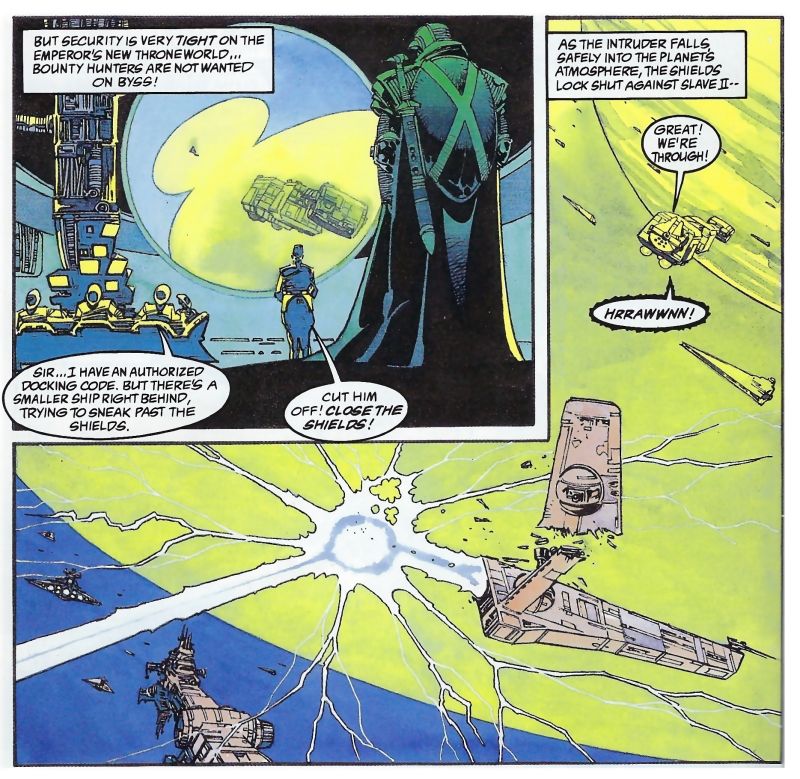
n Descriptions and illustrations of the Slave II from published sources do not agree with the published RPG stats Shields: 1D
. Please note graphic to the right from “Dark Empire” comic number 4 of 6. Likewise the stock Pursuer Enforcement Ship has Shields: 1D
.
“While Slave II suffered quite a bit of damage after its encounter with Byss’ planetary shield, it won’t be long until Fett is after Solo again...”
— Michael Allen Horne, “Dark Empire Sourcebook”,
page 100 (c. June 1993) (emphasis added)
“Slave II is essentially a heavy patrol craft with a superior hull and powerful Torplex military-grade shield generators.”
— Bill Smith, “The Essential Guide to Vehicles and Vessels”,
page 146 (c. March 19, 1996) (emphasis added)
Bill Smith used similar language describing the shields of Slave I:
“In addition to combat-grade shields and sensors, Slave I has an illegal sensor masking and jamming system that allows it to slip through sensor grids undetected.”
— Bill Smith, “The Essential Guide to Vehicles and Vessels”,
page 144 (c. March 19, 1996) (emphasis added)
The severity of the collision damage is further described in later sources that match the original comic artwork.
“Slave II was severely damaged over Byss when Fett, attempting to follow the Falcon down to the planet's surface, smashed into the planetary shield. The stabilizer bar was ripped off in the crash, and the ship was disabled. All things considered, Fett got off lightly—if Slave II's shields had been down, the shield would have incinerated the ship.”
— Bill Smith, “The Essential Guide to Vehicles and Vessels”,
page 146 (c. March 19, 1996) (emphasis added)
The above sources and the game data from the PC game indicate the shield rating from the RPG for the Pursuer stock model and Slave II are insufficient and are increased in this translation.
To survive such a collision with a planetary shield, the Slave II would better match its descriptions and images with shields similar to the Millennium Falcon (i.e. Shields: 3D
).
o The ship is aerodynamic, and has faster than normal atmospheric speed.
p The ship has Maneuverability: 1D+2 (2D+2 in atmosphere)
.
For this translation the TIE Advanced Fighter in the PC Game will be compared to the TIE Advanced Prototype flown by Darth Vader in the RPG. Some adjustments were necessary to differentiate between the prototype and the production model.
Below are the systems used on the TIE Interceptor.
Power System:
Propulsion System:SFS I-s3a solar ionization reactor
— Rusel DeMaria,
SFS P-s5.6 Twin ion engines (rated at 175 KTU)
“The Farlander Papers”, page 86 (c. February, 1993)
“X-Wing: The Official Strategy Guide”, page 344 (c. June 1993)
“The Stele Chronicles”, page 75 (c. July 20, 1994)
“X-Wing Collector's CD-ROM: The Official Strategy Guide”, page 518 (c. March 1995)
Below are the systems used on the TIE/Ad (TIE Avenger).
Power System:
Propulsion System:SFS I-s3a solar ionization reactor
— Rusel DeMaria,
SFS P-sx7.4 Twin ion engines (rated at 230 KTU)
“X-Wing: The Official Strategy Guide”, page 346 (c. June 1993)
“The Stele Chronicles”, page 81 (c. July 20, 1994)
“X-Wing Collector's CD-ROM: The Official Strategy Guide”, page 506 (c. March 1995)
Below are the systems used on the Darth Vader's Prototype TIE Fighter. Note this fighter uses the same propulsion system as used on the TIE Interceptor but a different propulsion system than the production TIE/Ad (TIE Avenger).
“The vessel mounted a Sienar Fleet Systems (SFS) I-S3a solar ionization reactor and paired SFS P-s5.6 twin ion engines for a for more powerful drive system than that of the standard TIE/In. Speed was only slightly improved over earlier models, due to the added mass and to the fact that a good deal of the extra power was bled off to the shield generators.”
“The Empire instead opted for the TIE interceptor, which featured the TIE Advanced x1's drive system, but in a more compact ship.”
— Bill Smith, “The Essential Guide to Vehicles and Vessels”,
page 30 (c. March 19, 1996) (emphasis added)
If the TIE Advanced and the TIE Interceptor used the same drive system and the TIE Advanced was the more massive ship, due to shields and hyperdrive, the 133 MGLT
metric is too fast but the production model used the experimental P-sx7.4 engines giving it the faster 133 MGLT
metric of the PC Game. The PC Game is assumed to be the production model and will be used in this translation.
Very little statistical data can be found in the original roleplaying game publications but some inferences can be found in some sources for comparison in this thesis.
“The TIE defender is one of the fastest production fighters ever used by the Empire: it's nearly 40 percent faster at sublight than the standard TIE/In. The TIE defender still follows the basic twin ion engine model, but it uses the newer P-sz9.7 engines to generate added speed.”
— Bill Smith, “The Essential Guide to Vehicles and Vessels,
page 176 (c. March 19, 1996) (emphasis added)
“The TIE defender's multiple heavy-weapons systems allow it to successfully engage enemy capital ships, while a hyperdrive allows it to operate independently of support carriers, giving the ship flexibility unmatched by any other Imperial starfighter. It is nearly 40 percent faster at sublight than the standard TIE fighter due to its new twin ion engines. Triple arrays of maneuvering jets on the tri-wing assembly make the ship capable of amazing dives and twists.”
— Stephen J. Sansweet, “Star Wars Encyclopedia”,
p. 308 (c. June 30, 1998) (emphasis added)
q Due to the above sources and for purposes of this translation, it is assumed the TIE/d Defender has a space speed of 13.9.
“The TIE defender is oddly shaped. Also odd is the fact that this ship has both a hyperdrive system and a powerful shield system. Its novel design enables it to perform difficult maneuvers, and only the A-wing and the TIE interceptor are more agile in battle. The defender also sports a powerful array of weaponry. As a complete package, the defender is arguably the best starfighter model available, able to handle itself against Alliance starfighters and to assault even heavy Alliance capital ships effectively.”
— Steve Honeywell, “Star Wars: Rebellion: Prima's Official Strategy Guide”,
pp. 259-260 (c. March 27, 1998) (emphasis added)
Due to numerous mistakes (e.g. Ion Cannons equipped on the TIE Bomber instead of the TIE Defender) found in the stats for the TIE Defender in the “Star Wars: Rebellion” PC game, the above maneuverability comment will be ignored for this translation.
“This first exercise will be a simple one. You'll find the Sienar Fleet Systems TIE Defender is the fastest, best-equipped starfighter in the galaxy. Unlike other TIE designs, it incorporates shields, which provide the pilot with an improved survival profile. It has four lasers that can be fired singly, linked, or quadded, as well as two ion cannons. It carries eight concussion missiles or proton torpedoes depending upon mission profile, and has a tractor beam. It is very fast and highly maneuverable, both in space and atmosphere. Finally, it has hyperspace drive, which allows the ship to accomplish deep space missions without requiring a larger ship to deliver it to the target."
— Michael A. Stackpole, “X-Wing: Isard's Revenge”,
Chapter 25, page 220 (April 13, 1999) (emphasis added)
The above reference will be used to configure the firing linking modes of the TIE Defender in its final game stats.
—As he came in tight he chopped his throttle back, and then activated the Defender's tractor beam. It latched hold of the space station, but since it massed far more than the star-fighter, it didn't go anywhere. Instead the tractor beam acted like a line that shortened the arc of Corran's turn.”
— Michael A. Stackpole, “X-Wing: Isard's Revenge”,
Chapter 25, page 227 (April 13, 1999) (emphasis added)
The above reference will be used to produce descriptive text for the TIE Defender's tractor beam system.
—Corran set the Defender down and switched the ship into a passworded standby mode.”
— Michael A. Stackpole, “X-Wing: Isard's Revenge”,
Chapter 34, page 293 (April 13, 1999)
The above reference will be used to produce descriptive text for the TIE Defender's game stats.
“The TIE Defender was one of the best starfighters known. Equipped with three sets of solar wing arrays, equally spaced around the spherical fuselage, instead of two, and outfitted with shields equal to an X-wing's and weapons and speed superior to the X-wing, it was an extraordinary—and extraordinarily costly—starfighter.”
— Aaron Dale Allston, “X-Wing: Starfighters of Adumar”,
Chapter 14, page 279 (August 3, 1999) (emphasis added)
In the “X-Wing Alliance” PC Game, the shield metrics for the TIE Defender are 100 RU as compared to the X-Wing with 50 RU. The above shield comment will be ignored for this translation.
r The TIE/sa Bomber has the worst maneuverability in this category (Type 0, Fighters) of the study Maneuverability: 0D
. It is suspected that because the bomber was not included in the Relative Speed / Maneuverability Chart (see Fig. 1), it was biased negatively by an increased measure when game balance was being considered. When compared to the X-Wing Alliance data it becomes apparent an error was made in the stats of this fighter that were carried over to all editions and iterations of the ship in the RPG. For purposes of this thesis, this bomber will be given improved maneuverability for this translation.
“ Each cannon is equipped with a targeting mechanism adapted from the one used in Sienar Fleet Systems' TIE bomber craft. This produces multi-fire cover with superb fire control. ”
— Greg Gordon, “Imperial Sourcebook”,
First and Second Editions, p. 55 (emphasis added)
Concussion Missile Fire Control was improved from 3D
in First Edition to 3D+2
in Second Edition rules. This Second Edition correction is assumed to be the result of the subsequent publication of the First Edition “Imperial Sourcebook” by Greg Gordon.
s This fighter has had inconsistent spellings of its model name throughout its RPG publication history.
Tocsan 8-Qin: “Alliance Intelligence Reports” (8x), pages 44, 47, 50, 51.
Tocsan Q-8in: “Secrets of the Sisar Run”, page 24.
Toscan 8-Qin: “Pirates & Privateers” (4x), pages 53, 128.
t The stats for the fighter do not match the descriptions below:
“Capsule: One of the few production starfighters to come out of the Shobquix factories, the Tocsan 8-Q starfighter uses a Koensayr cockpit. The Tocsan 8-Q remains popular with pirate groups and other small military forces. particularly in lower-tech regions such as Wild Space and the Unknown Regions. The m'Yalfor'ac models have been stripped of their hyperdrives and their ship systems modified to substantially increase speed and firepower.”
— Craig R. Carey and Trevor J. Wilson, “Alliance Intelligence Reports”,
page 50 (c. June 1995) (emphasis added)
Substantially increase speed and firepower
??? Space: 7
, Atmosphere: 350; 1,000 km/h
does not sound like a substantial
increase in speed for a ship stripped of hyperdrive, shields, missiles/torpedoes, and any other ship systems
included in the modifications.

As for firepower
the m'Yalfor'ac models have the identical weapons as the stock model on page 53 of “Pirates & Privateers”. The published stats do not match the included descriptions and artwork (see side graphic), suggesting the published stats contain TYPOs. In the side graphic we see 4 wing-mounted weapons and 2 front-mounted cannons. It is possible the stats for the four wing-mounted weapons were omitted in error in the publication, as it is possible they would have appeared at the end of the stat block and were clipped. In X-Wing Alliance, these wing-mounted weapons are 4 Laser Cannons, and the 2 front-mounted weapons are Ion Cannons. The X-Wing Alliance interpretation of this fighter resemble the original image and descriptions from pages 50-51 of “Alliance Intelligence Reports” better than the published stats.
Just like the Firespray-class above, West End Games® excessively reduced the performance of the stock model when a highly modified ship, of the same model, was published first. The Z-95 Headhunter Mark I is another example of this trend. The stock Toscan 8-Q is no exception.
uHull: 2D
and no shields makes perfect sense for a modified
ship stripped down for speed. This also suggests the stock model would have significantly more armor (Hull rating) being that it uses a Koensayr cockpit
(Y-Wing), and would also be equipped with shields. The model used for translation will have an increased Hull rating, and be equipped with Shields like the equivalent model used in X-Wing Alliance.
No official game stats for the Incom T-65C-A2 X-Wing were published by West End Games®. The game stats for the newer T-65AC4 and older Incom T-65B X-Wing will be used for comparison in this translation with the understanding that the T-65C-A2 has performance somewhere between the T-65AC4 and the T-65B.
v It is highly suspected due to the comparative metrics that the Xizor Fighter is representative of the mass-produced StarViper-class Attack Platform and not the personal transport of Prince Xizor, the Virago. Adjustments to reduce ship performance will be noted on data charts with specifics to compensate for translation.
w Atmospheric speed TYPO published as 1,200 km/h instead of 1,250 km/h (rules as written).
x Atmospheric speed: 210; 600 km/h (with wings extended).
y Maneuverability: 1D in atmosphere with wings extended.
z Hull: 6D (front), 3D (back). Hull ratings front and back, will be averaged for simplicity in this translation.
aa Shields: 1D (front), 4D (back). Shield ratings front and back, will be averaged for simplicity in this translation.
Note: The Y-wing BTL-A4 Longprobe on page 83 of “The Rebel Alliance Sourcebook”, Second Edition, has the same Hull and Shield Rating as the First Edition Y-wing (see Fig. 2). All Second Edition standard Y-wings (BTL-S3) have consistent 4D Hulls and 1D+2 Shields throughout the Second Edition RPG.
Hull and Shield metrics from the PC game match the stats for BTL-S3 in spite of the crew metrics being 1
. This may be an issue of programming limitations adding a second player to the Y-Wing, in the PC game, to operate the Ion Cannon Turret. The Translation will assume the Y-Wing is the BTL-S3.
Comparing the X-Wing Alliance metrics of the Z-95 Headhunter and X-Wing, it was determined the best match for comparison are from the latest models so comparisons will be based on the Z-95 AF4, and the Z-95 Mark II.
Note: The speed of the Z-95 Headhunter Mark II published in “Classic Adventures”, Volume 1, page 50 contained a TYPO. Space: 5
and Atmosphere: 365; 1,050 km/h
were printed which is incorrect and matches the published stats for the Z-95 Headhunter Mark I. It is possible this was a copy/paste error. For this translation we will use the normal stat of Space: 7
for comparison (see the “Star Wars® Sourcebook”, Second Edition, page 15, for more info.)
ab To compound the speed problem, the mismatched space speed of 7 and atmospheric speed of 400; 1,150 km/h that was published do not match the chart Ships in Atmosphere
on page 110 of “Star Wars® The Roleplaying Game”, Second Edition (blue Darth Vader cover) and page 129 of “Star Wars® The Roleplaying Game”, Second Edition, Revised & Expanded (see Fig. 3 and Fig. 3a for more info).
The speed classes, rules-as-written:
This speed (365; 1,050 km/h) suggests a Z-95 Headhunter that can outrun an X-Wing in atmosphere must be significantly more aerodynamic than an X-Wing. It is believed the original Z-95 Headhunter stats are for the swing-wing bubble cockpit model described in the novel “Han Solo at Stars' End”.
It is also suspected the slower Z-95 Mark I Headhunter is incorrect but exceeds the scope of this thesis and is only noted for completeness (see pages 103-104 of the “Han Solo and the Corporate Sector Sourcebook” for more info).
The Z-95 Headhunter that appeared in the X-Wing Alliance PC game is a newer model possibly the Z-95-AF4 (Assault Fighter 4) with upgraded engines, and weapons with a fuselage of similar aerodynamics to the T-65 X-Wing (see “The Essential Guide to Vehicles and Vessels”, page 200 for more info).
ac Z-95 Headhunter Mark II maneuverability is used, Maneuverability:1D+2
, in this translation (see “Classic Adventures”, Volume 1, page 50 for more info).
ad Newer Z-95 Headhunters are noted as follows:
New generations seem to be coming along every few years — it wasn’t that long ago that a Z-95 Headhunter could hold its own under the right conditions. Now, it is simply a very fast coffin.
— Michael Allen Horne, “Dark Empire Sourcebook”,
page 101 (c. June 1993) (emphasis added)
Comparing the data between both systems, it was discovered that the newer Headhunters trade Hull rating for speed and hyperdrive capabilities.
In the chart below are the Starfighter Performance Metrics for the “X-Wing Alliance” PC Game. Due to the fact the PC game is only played in the regime of space, we will solve for those metrics and interpolate atmospheric performance. These metrics will be combined and added to a scatter diagram to solve for:
The starfighter performance data between the X-Wing PC Game (c. February 1993), and the TIE Fighter PC Game (c. July 1994) are identical. Subtle adjustments were made to the starfighters seen in the Original Trilogy, and Z-95 Headhunter in the X-Wing Vs. TIE Fighter PC Game (c. April 1997). The TIE Defender was removed from the X-Wing Vs. TIE Fighter PC Game for game balance. Here we see evidence of thorough playtesting with the first two PC Games over thousands of sorties of play. This third main installment, X-Wing Vs. TIE Fighter, with multi-player capability allowed Lucasarts ample play data with player vs. player gameplay to polish and refine performance data by many orders of magnitude over the tabletop RPG. With the advent of the fourth main installment, the X-Wing Alliance PC Game (c. February 1999) performance data was refined and tuned to further improve game balance. Specific changes are noted on the chart below.
Rebel fighters are believed to have been given enhanced stats to make RPG gameplay easier for players. In contrast Imperial fighters were given weakened stats for the RPG. These bias corrections are noted on the data charts marked in orange to indicate changes needed to harmonize the data of the two game systems.
| Ship Type | Speed MGLT | Accel- eration MGLT/ sec | Decel- eration MGLT/ sec | Roll | Pitch /Yaw | Maneu- vera- bility DPF | Hull Rating RU | Sys- tem Hits | Explosive Power/ Collision Damage | Shield Rating SBD | Shield Re- charge | Shield De- charge |
|---|---|---|---|---|---|---|---|---|---|---|---|---|
| A-Wing RZ-1 (A-W) | 120 | 21 | 40 | 48 | 24 | 96↓a | 14↓b | 10 | 500 | 50 | 20 | 15 |
| Assault Gunboat (GUN) | 90 | 20 | 33 | 40 | 18 | 76↓↓c | 28 | 10 | 2,500 | 100 | 20 | 10 |
| Authority IRD (IRD) | 102 | 18 | 27 | 31 | 17 | 65 | 18 | 8 | 1,300 | 35 | 11 | 8 |
| B-Wing (B-W) | 91 | 16 | 23 | 34 | 18 | 70↑d | 60 | 20 | 4,500 | 100↓e | 20 | 6 |
| Cloakshape Fighter (Clk/F) | 93 | 20 | 29 | 35 | 19 | 73 | 28 | 10 | 2,300 | 96 | 16 | 10 |
| Firespray Attack Ship (FRS) | 91 | 16 | 23 | 35 | 19 | 73 | 62 | 14 | 4,500 | 106 | 22 | 8 |
| Preybird Fighter (Pry/F) | 100 | 13 | 19 | 36 | 28 | 92 | 18 | 10 | 1,000 | 46 | 13 | 8 |
| Pursuer Enforcement Ship (PES) | 94 | 15 | 20 | 33 | 17 | 67 | 60 | 12 | 4,400 | 100 | 21 | 6 |
| Skipray Blastboat (S/B) | 91 | 16 | 23 | 32 | 16 | 64 | 61 | 14 | 4,500 | 102 | 20 | 6 |
| T-65C A2 X-Wing (X-W) | 100 | 16 | 27 | 36 | 20 | 76 | 20 | 10 | 700 | 50 | 15 | 10 |
| TIE Advanced (T/A) | 133↓f | 16 | 22 | 50 | 28/26g | 104↓h | 14↓i | 10 | 1,000 | 40↓j | 25 | 18 |
| TIE Bomber (T/B) | 80 | 13 | 20 | 42 | 22 | 86↑k | 28↓l | 10 | 1,500 | 0 | 0 | 0 |
| TIE Defender (T/D) | 144↓m | 21 | 33 | 50 | 32 | 114↓n | 14↓o | 10 | 1,250 | 100↓p | 40 | 22 |
| TIE Fighter (T/F) | 100 | 20 | 23 | 46 | 26 | 98 | 9 | 10 | 500 | 0 | 0 | 0 |
| TIE Interceptor (T/I) | 111↑q | 21 | 27 | 50 | 28/26r | 104↓s | 16↓t | 10 | 1,000 | 0 | 0 | 0 |
| Toscan Fighter (TOS) | 86 | 14 | 21 | 35 | 19 | 73 | 23 | 10 | 1700 | 68 | 13 | 9 |
| Xizor Fighter (Xiz/F) | 98 | 16 | 24 | 36 | 20 | 76 | 22 | 10 | 1,100 | 50 | 14 | 10 |
| Y-Wing BTL-A4 (Y-W) | 80 | 11 | 20 | 28 | 16 | 60↑u | 40 | 20 | 3,000 | 75 | 10 | 4 |
| Z-95 Headhunter (Z-95) | 100↑v | 16 | 23 | 42 | 22 | 86↑w | 14↓x | 10 | 500 | 20 | 8 | 4 |
|
||||||||||||
Hoersh - Kessel Drive, Inc..
Hoersh - Kessel Drive, Inc..
f 145 MGLT in X-Wing PC & TIE Fighter PC, decreased to 133 MGLT in X-Wing vs. TIE Fighter PC and X-Wing Alliance PC.
Data files in the PC Game indicate this fighter does not have a hyperdrive. This matches the modified m'Yalfor'ac models from “Alliance Intelligence Reports”, page 50 but the stock models from “Pirates & Privateers”, pages 53 have Hyperdrive: x2
. The final translation will include a class 2 hyperdrive.

Fig. 4 Study of empty Droid Sockets on the original Artwork from “Alliance Intelligence Reports”,
page 51 by artist Matt Busch and the 3D mesh from the “X-Wing Alliance” PC Game.
It should also be noted that both the original artwork by Matt Busch and the 3D mesh from the PC game have an empty droid socket. In the absence of a hyperdrive as indicated on the modified m'Yalfor'ac models it would also be logical to remove the astromech droid to reduce weight. It appears this was erroneously carried over to the 3D model. Our final translation will include a droid socket to accommodate an Astromech droid to serve as an Astrogation Buffer.
The metrics to be translated to game stats will each require their own formula to solve for and will be calculated separately. One can not be sure, when observing the PC game data, that Totally Games® decided to start over with a clean slate when designing the metrics for the X-Wing series of games. They may have coordinated with West End Games® to correct issues with the RPG stats. By translating game metrics into RPG stats, any game balance biases, mistakes, and TYPOs, inherited from the RPG, can be identified, and eliminated.
The PC game CD has speed metrics that are the equivalent of a fighter set on maximum power to the weapons and shields and set to the minimum power to the engines. The strategy guide indicates its speed metrics are set to maintenance for weapons and shields or a balanced setting. We used the metrics at this setting to translate speeds to the RPG because there are no core rules-as-written for power management in the RPG and it is assumed the RPG uses a balanced mode as its default for its stats.
“Speed represents a craft's maximum velocity with its recharge rates all at maintenance.”
— John Drake, “Star Wars: X-Wing Alliance: Prima's Official Strategy Guide”,
page 214 (c. May 3, 1999)
Using the X-Wing Alliance balanced Speed MGLT metric and comparing it to the West End Games® Space Speed stats, we used a linear trendline and linear regression to extract the translation formula. A linear trendline was the best fit for translation of the two systems.
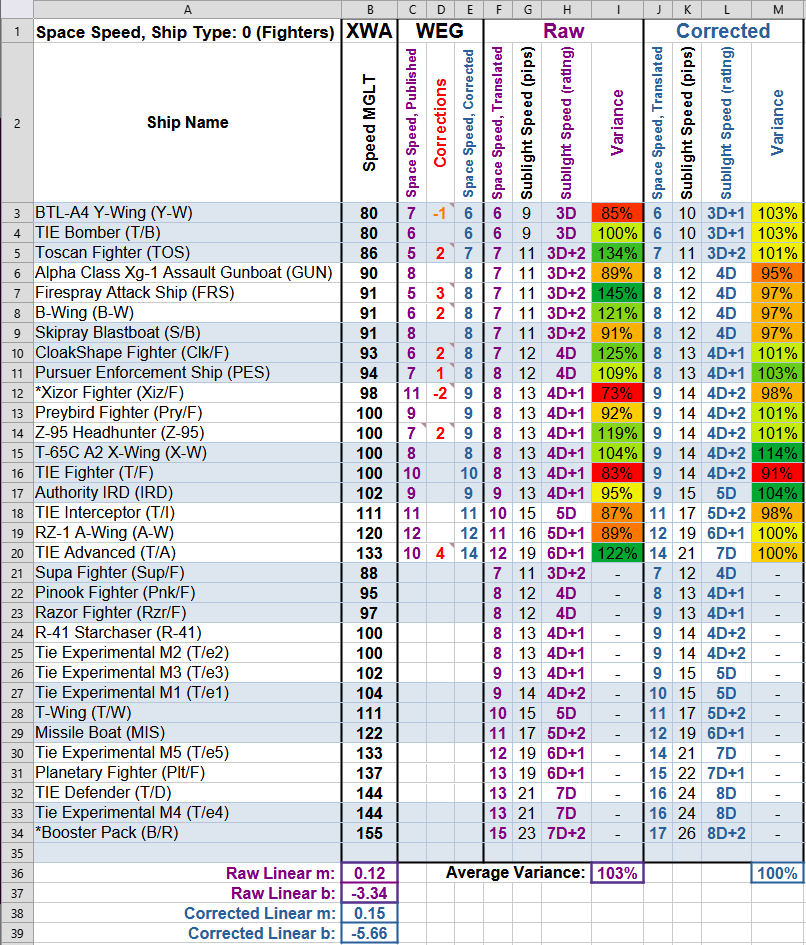
Fig. 5 X-Wing Alliance compiled data comparing PC Game Speed MGLT metrics to West End Games® RPG stats.
The first calculation compares the raw published data from X-Wing Alliance Strategy Guide to the raw uncorrected published data from West End Games®. The results of the raw translation can be observed on column F (purple).
The second calculation includes corrections to the published RPG game stats (column D, in red). The results of the corrected translation can be observed on column J (blue).
Note: X-Wing Alliance fighter speeds depicted in orange on column B, *Xizor Fighter (Xiz/F) and *Booster Pack (B/R), did not appear in the strategy guide and are calculated results using the data from the game CD and multiplying it by the average variance (1.125) of the metrics in the strategy guide.
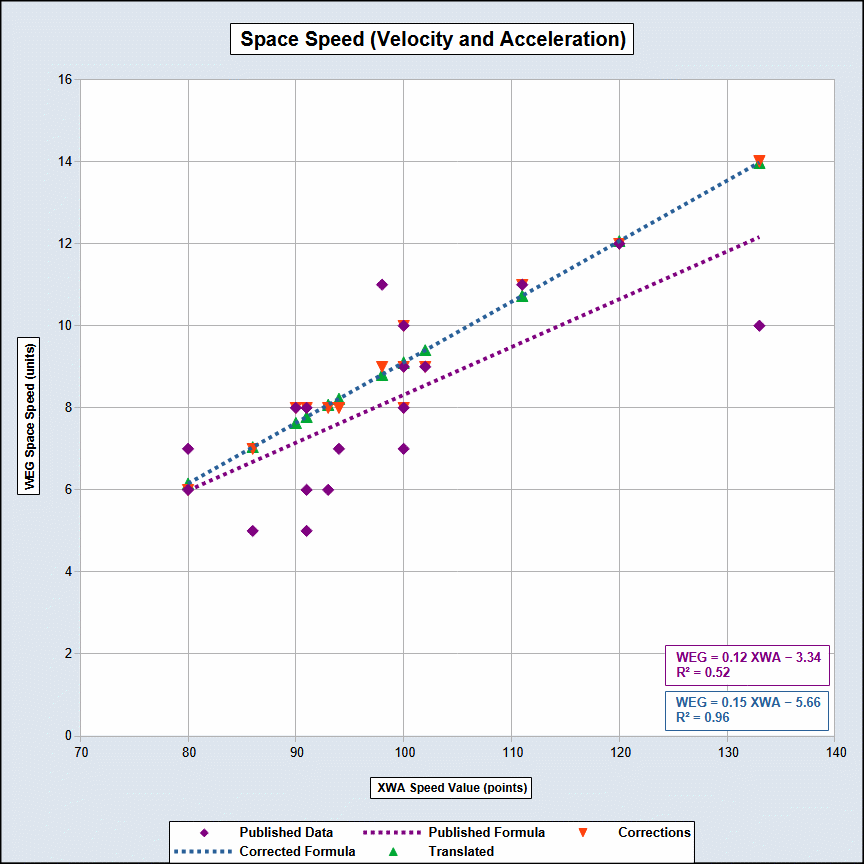
Fig. 6 X-Wing Alliance scatter chart comparing PC game speed metrics to West End Games® RPG stats.
In the above scatter diagram, we plotted the relationship of the published, corrected, and translated game stats. Two linear trendlines illustrate the change in formulae due to the corrections made to the West End Games® stats.
After calculating the space speeds of the starfighters, it was discovered that some of the ships exceeded the maximum space speed as charted in the original RPG rules-as-written, (i.e. Space: 12
). We then took the original charts from the First Edition, Second Edition, and Revised & Expanded rulebooks and placed them side-by-side for comparison. We then reverse-engineered the formulas to extend the charts for the faster ships.

Fig. 7 Ships in atmosphere based on, “Star Wars: The Roleplaying Game”, Second Edition, page 110 (c. October 1992),
and “The Star Wars Roleplaying Game”, Second Edition, Revised and Expanded, page 129 (c. August 1996)
We quickly discovered a pattern of increments noting that the space speeds were not consistent with their atmospheric equivalents. For example, a space speed of 1 is half of a space speed of 2 but in atmosphere 210 meters per round is not half of 225 meters per round as indicated by the original charts. We also discovered an incremental and repeating pattern of +15, +35, +20 meters per round as we progress down the chart to faster speed classes.
It was at this point we discovered some math errors in the pattern as well as some rounding errors in kilometers per hour columns for all-out speeds. These errors are noted in red on the above chart. We then proceeded to remaster the chart on a spreadsheet to correct the incremental repeating pattern, and recalculated the all-out speeds rounding them to the nearest tens. We continued the chart to Space: 20
to exceed our needs and provide for faster vessels if needed in the future.
Translation of ship maneuverability was accomplished by comparing the maneuverability metric for the PC game in the strategy guide (average of pitch, yaw, and roll, at optimum speed for maneuverability F12) to the maneuverability game stats of the RPG.
Key
F11
F12Effect
Full throttle, lasers at increased,
shields at maintenance
One-third throttle, lasers, and
shields at Maintenance.Description
— John Drake, “Star Wars: X-Wing Alliance: Prima's Official Strategy Guide”,
This keeps energy entering the system,
with a minimal Impact on speed. It's a good
general-purpose setting.
This setting gives your craft the optimal turn
rate. It's great for close-up twisty dogfights.
page 9 (c. May 3, 1999)
Maneuverability is an average of a craft's pitch (nose up and down), yaw (nose left and right), and roll (rotation around a central point).
— John Drake, “Star Wars: X-Wing Alliance: Prima's Official Strategy Guide”,
page 214 (c. May 3, 1999)
We then used a linear trendline and linear regression to extract the translation formula. A Linear trendline was the best fit to balance the least and most maneuverable fighters in the segment.
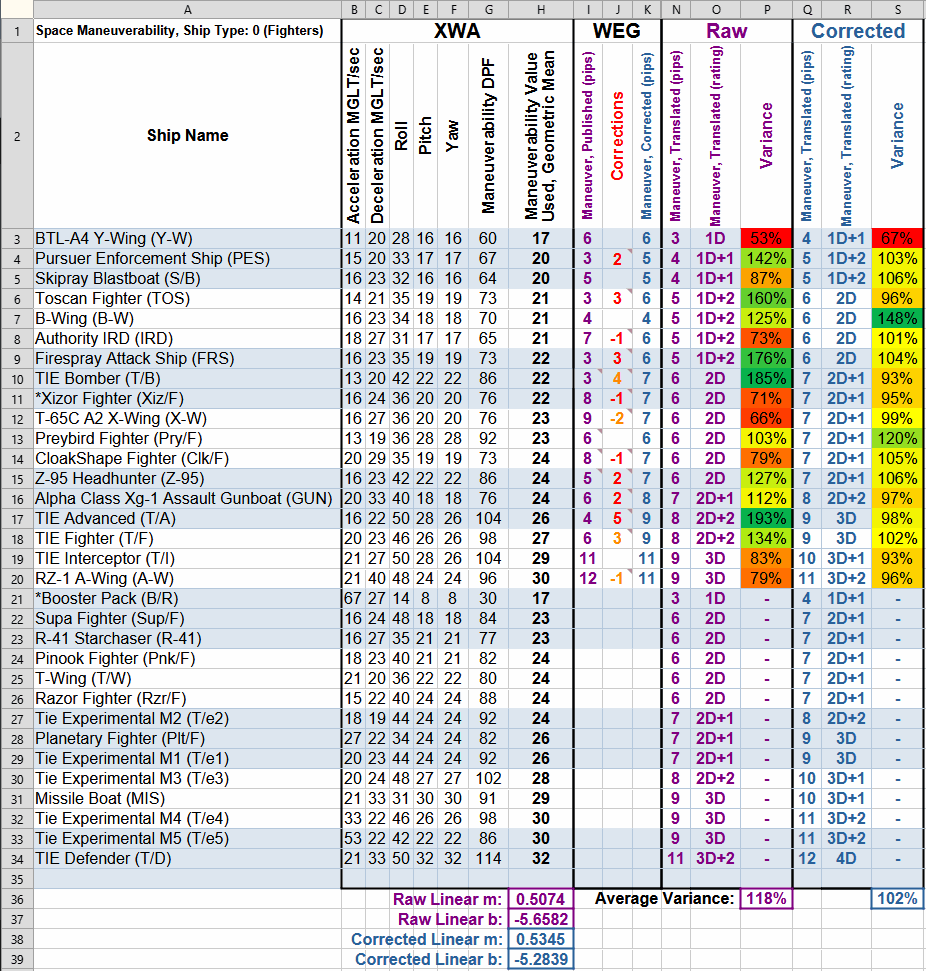
Fig. 8 X-Wing Alliance compiled data comparing PC game maneuverability metrics to West End Games® RPG stats.
The first calculation compares the raw uncorrected published data from West End Games® to the raw extracted data from X-Wing Alliance. The results of the raw translation can be observed on column F (purple).
The second calculation includes corrections to the published game stats from column D (red). The results of the corrected translation can be observed on column I (blue).
Note: X-Wing Alliance fighter maneuverability depicted in orange on column B (*Xizor Fighter (Xiz/F) and *Booster Pack (B/R)) did not appear in the strategy guide and are estimated results using data from the game CD and multiplying it by the average variance (1.24) of the metrics in the strategy guide.
*Booster Pack (B/R) maneuverability was calculated to -1 pips in Starfighter-scale (cell I21). This translates to a maneuverability 1D+2 in Walker-scale.
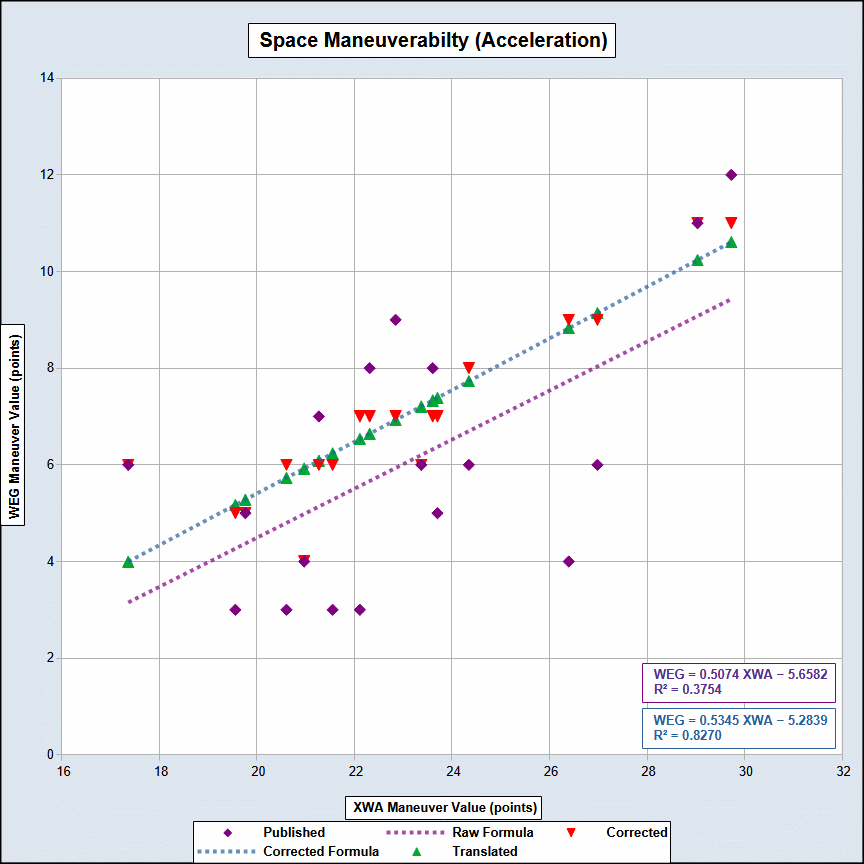
Fig. 9 X-Wing Alliance scatter chart comparing PC game maneuverability metrics to West End Games® RPG stats.
In the above scatter diagram, we plotted the relationship of the published, corrected, and translated game stats. Two linear trendlines illustrate the change in formulae due to the corrections made to the West End Games® stats.
Translation of ship Hull (Damage Resistance) was accomplished by first creating a geometric mean of all the X-Wing Alliance structural metrics using the following formula:
x = (Hull-Rating * System-Hits * Explosive-Power/Collision-Damage) ^ (1/3)
Using the geometric mean and comparing it to the West End Games® stats, we then used a power trendline and linear regression to extract the translation formula. A power trendline was the best fit to extract the very incompatible data between the two very different game systems (hit points vs. damage resistance).

Fig. 10 X-Wing Alliance compiled data comparing PC game Hull (Damage Resistance) metrics to West End Games® RPG stats.
The first calculation compares the raw uncorrected published data from West End Games® to the extracted data from X-Wing Alliance. The results of the raw translation can be observed on column I (purple).
The second calculation includes corrections to the published game stats from column G (red). The results of the corrected translation can be observed on column L (blue).
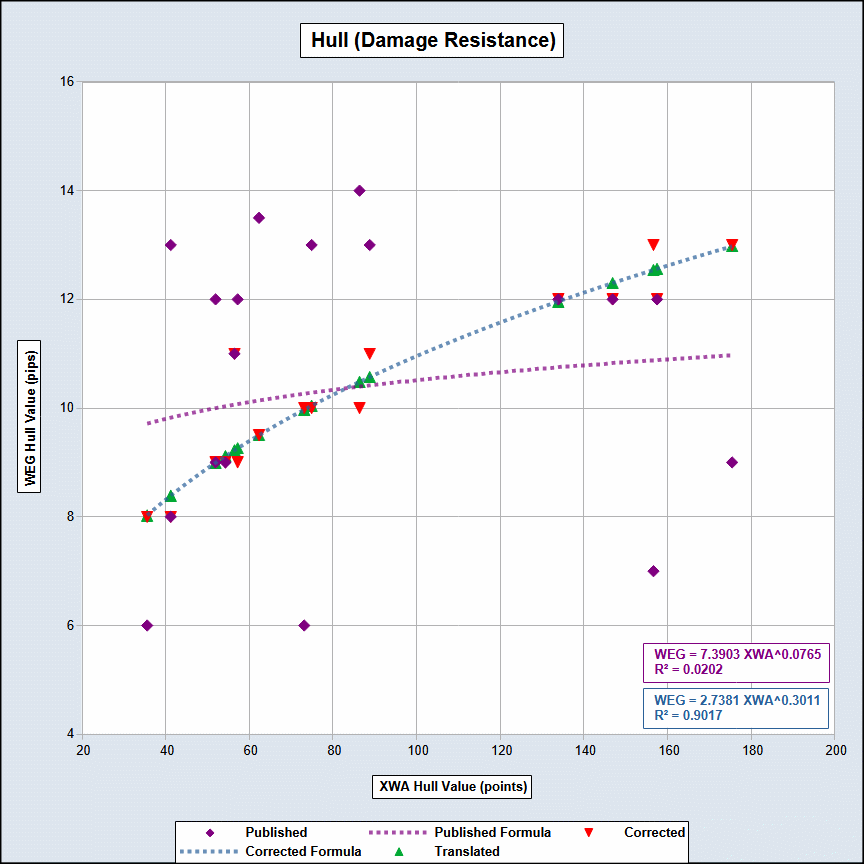
Fig. 11 X-Wing Alliance scatter chart comparing PC game Hull (Damage Resistance) metrics to West End Games® RPG stats.
In the above scatter diagram, we plotted the relationship of the published, corrected, and translated game stats. Two power trendlines illustrate the change in formulae due to the corrections made to the West End Games® stats.
Translation of ship Shields was accomplished by using the Shield Rating metric and comparing it to the West End Games® stats, we then used a power trendline and linear regression to extract the translation formula. A power trendline was the best fit to insure minimum shielding of 3 pips (1D) and to prevent excessive game-imbalancing shielding for the more powerful fighters in the category..
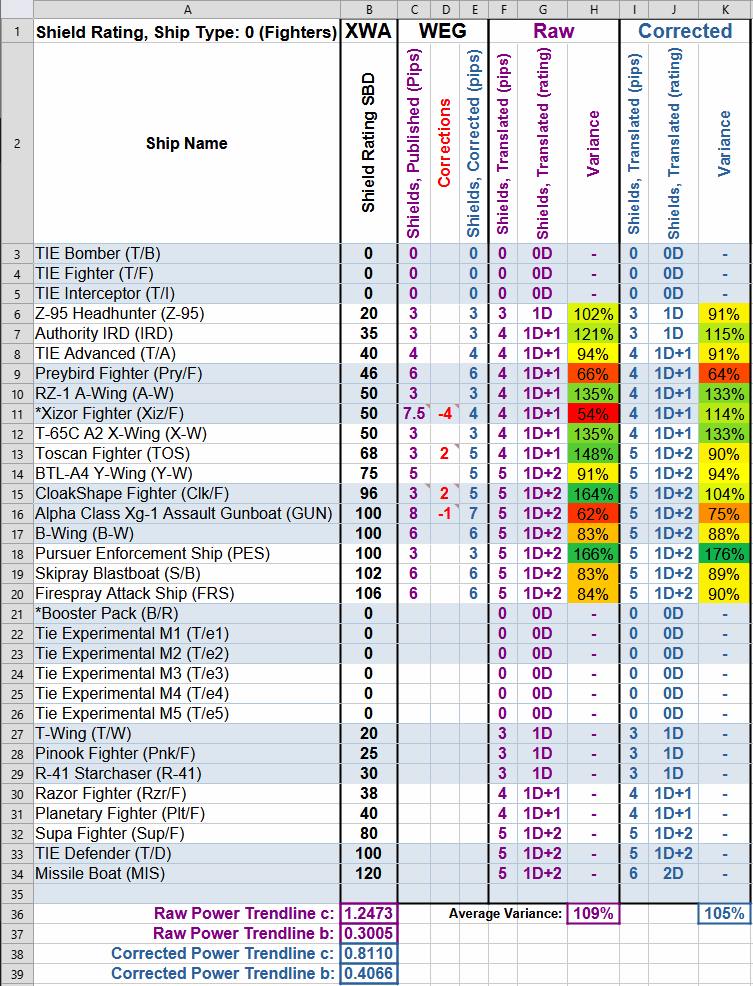
Fig. 12 X-Wing Alliance compiled data comparing PC game Shield (Damage Resistance) metrics to West End Games® RPG stats.
The first calculation compares the raw uncorrected published data from West End Games® to the extracted data from X-Wing Alliance. The results of the raw translation can be observed on column F (purple).
The second calculation includes corrections to the published game stats from column D (red). The results of the corrected translation can be observed on column I (blue).
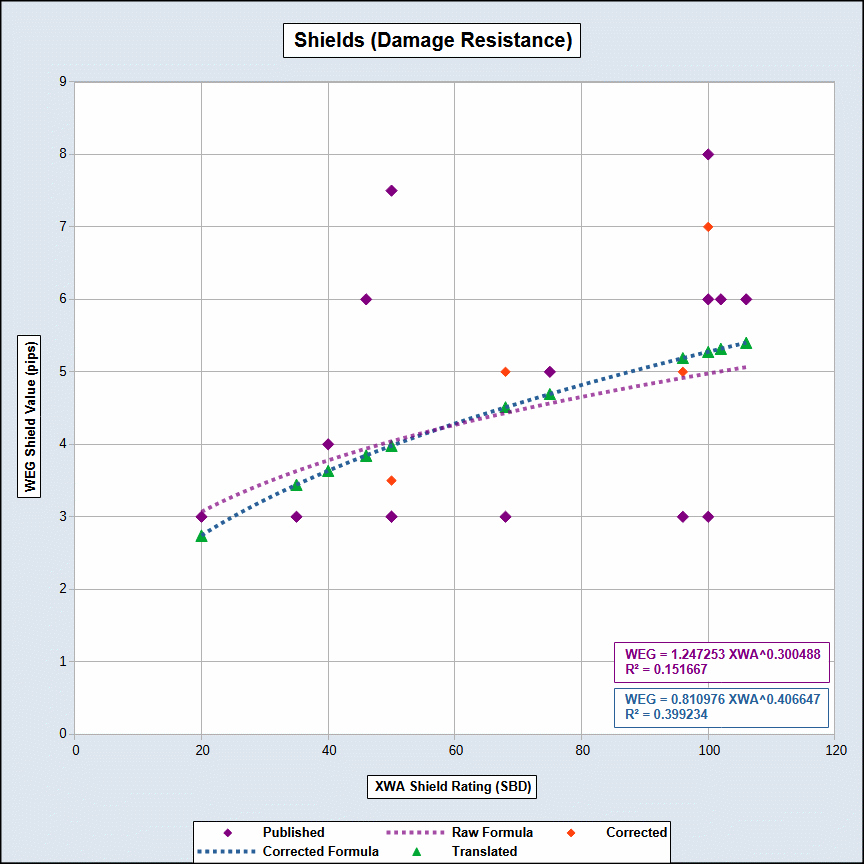
Fig. 13 X-Wing Alliance scatter chart comparing PC game Shield (Damage Resistance) metrics to West End Games® RPG stats.
In the above scatter diagram, we plotted the relationship of the published, corrected, and translated game stats. Two power trendlines illustrate the change in formulae due to the corrections made to the West End Games® stats.
The Translation of Hyperdrives from the PC game to the RPG have proven difficult due to the fact the PC games lack a speed metric for faster-than-light travel. Ships simply jump into hyperspace a graphic visualization is displayed and the ship in question arrives at its interstellar destination. Where possible various metrics from the game such as System Hits, Point Value, and Explosive Power / Collision Damage will be used as sources of comparison to determine the speed of the main hyperdrive, the presence of a backup Hyperdrive, etc.
One of the last considerations taken into account was the readability of game stats. The format and template of space transport game stats have not changed since the birth of Second Edition rules released in October of 1992. The arrival of the Revised and Expanded Edition of the game in August 1996 made no significant changes to the format, readability, and speed of random access to the stat block. Through play-testing we found finding specific stats during the heat of space combat to be confusing and slow. In the interest of making the game faster and more intense
we broke up the stat block into a series of categories and sub-lists to affect faster location of any given stat necessary for combat when needed. Below are the final results of our analysis.
Sublight Speedstat grandfathered and brought back from the First Edition SWRPG. This was done to allow for First Edition backwards-compatibility and to add an additional SWRPG tool for Gamemasters and Players to use.
meters per round.
Space Units, or
Space Units per Round.
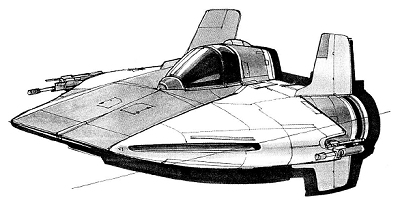
Capsule: Interceptor. Although more fragile than other Alliance fighters, its excellent speed and maneuverability make this craft a formidable dogfighter.
1.5 kmwas the published range which disagrees with the
2.5 kmrange found on the Starfighter-Scale Weapons chart on page 165 of “Star Wars®: The Roleplaying Game”, 2nd Edition, rulebook (blue Darth Vader cover).
Concussion Missiles are equipped with their own shields. The Missile Launcher does not have shields but relies on the shields of the host ship if equipped.
“The concussion missile's armored tube carries the warhead, a guidance computer, and a propellant system. Exterior shield projectors wrap the missile in a protective energy shroud, giving it the appearance of an elongated laser cannon.”
— Bill Smith, “The Essential Guide to Weapons and Tecnology”,
page 78 (c. October 23, 1997) (emphasis added)

Capsule: Space superiority fighter. Excellent multi-role craft. The first general deployment Imperial fighter designed with shields and hyperdrive.
Heavy Weapons — Starfighter Scalechart published in the “Star Wars® Gamemaster Kit”. The mistake was found by former West End Games® employee Todd Quigley who also discovered the error was copied into the second edition rules. In an interview, Todd Quigley corrected the long range stat to 14 units in space, and 1.4 km in atmosphere.
Concussion Missiles are equipped with their own shields. The Missile Launcher does not have shields but relies on the shields of the host ship if equipped.
“The concussion missile's armored tube carries the warhead, a guidance computer, and a propellant system. Exterior shield projectors wrap the missile in a protective energy shroud, giving it the appearance of an elongated laser cannon.”
— Bill Smith, “The Essential Guide to Weapons and Technology”,
page 78 (c. October 23, 1997) (emphasis added)
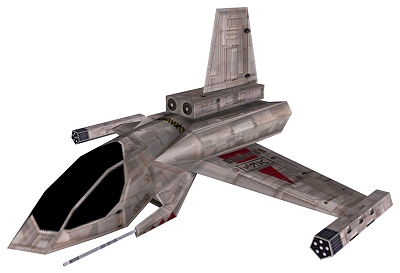
Capsule: Multipurpose starfighter. The IRD (Intercept Reconnaissance Defense) is designed for combat with powerful engines and very effective weaponry.
1 Twin Blaster Cannonon page 103 of the “Han Solo and the Corporate Sector Sourcebook”. With the exception of the name, the stats for the 2 laser cannons are identical to 2 of the 4 Laser Cannons mounted on the TIE Interceptor and have been labeled accordingly.
eis indicative of the enhanced Fire Control of the weapon system.
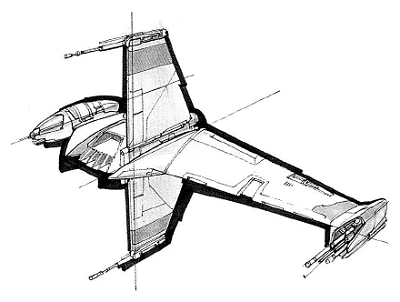
Capsule: Heavy assault fighter. Much improved combat ability makes this an excellent replacement for the Y-wing.
The B-wing features a very sophisticated but fragile gyroscopically-stabilized command pod, as well as a ranging mode for the laser cannon.
If, for some reason, the ranging laser is not operational, reduce all fire control codes by -1D.
The B-wing's gyroscopic stabilization system fails when it suffers heavy damage. In game terms. When the fighter is heavily damaged, a roll of 1-2 (used to determine which system is damaged) means the stabilization system has failed. Reduce all fire control codes by -1D (since the craft is no longer a stable platform), and sublight speed from 6 to 2 (atmosphere speed goes from "330 m/r; 950 km/h" to "225 m/r; 650 km/h").
These penalties are cumulative.
1.5 kmwas the published range which disagrees with the
2.5 kmrange found on the Starfighter-Scale Weapons chart on page 165 of “Star Wars®: The Roleplaying Game”, 2nd Edition, rulebook (blue Darth Vader cover).
Proton Torpedoes are equipped with their own shields. The Torpedo Launcher does not have shields but relies on the shields of the host ship if equipped.
“Proton torpedoes use sophisticated guidance computers to home in on their targets. Each torpedo is wrapped in a protective energy envelope to prevent accidental detonation caused by collisions with debris or near misses by laser cannon blasts.”
— Bill Smith, “The Essential Guide to Weapons and Technology”,
page 76 (c. October 23, 1997) (emphasis added)
Heavy Weapons — Starfighter Scalechart published in the “Star Wars® Gamemaster Kit”. The mistake was found by former West End Games® employee Todd Quigley who also discovered the error was copied into the second edition rules. In an interview, Todd Quigley corrected the long range stat to 14 units in space, and 1.4 km in atmosphere.
Fire Rate: 5from this weapon will be used on the Gyrhil 72 Auto-Blaster for this translated B-Wing.
Fire Rate: 5of the Gyrhil 72 Auto-Blaster imparts a damage bonus as seen in the stats above. This bonus can be applied in several ways as the Gamemaster/Player desires.
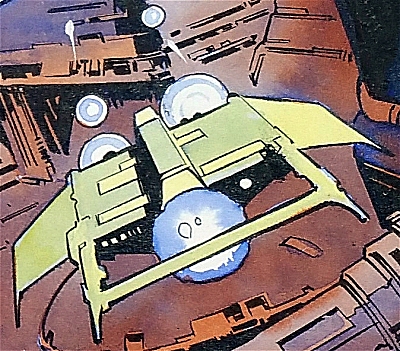
Capsule: Assault starfighter. One of many older starfighters now mostly used by smugglers, pirates, bounty hunters and other groups. Trades speed for durability.
Concussion Missiles are equipped with their own shields. The Missile Launcher does not have shields but relies on the shields of the host ship if equipped.
“The concussion missile's armored tube carries the warhead, a guidance computer, and a propellant system. Exterior shield projectors wrap the missile in a protective energy shroud, giving it the appearance of an elongated laser cannon.”
— Bill Smith, “The Essential Guide to Weapons and Technology”,
page 78 (c. October 23, 1997) (emphasis added)
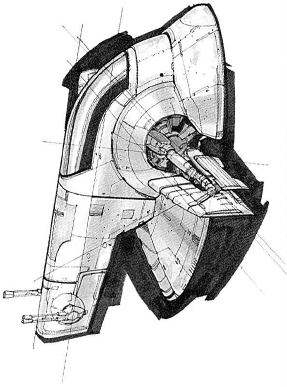
Capsule: Patrol and attack ship originally designed for planetary law enforcement and interdiction duty. Can easily be modified for special purposes.
originally designed for planetary law enforcement and interdiction duty, there is a need by some constabularies to apprehend criminals and pirates. Logically these craft would come equipped with a hardpoint and necessary wire harnesses to install a compact Tractor Beam or any compatible beam weapon to this end.
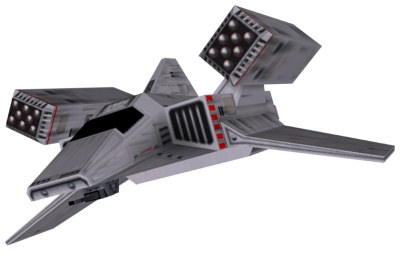
Capsule: Advanced space superiority fighter. Superior shielding, speed and multiple warheads make this fighter a dangerous opponent for Alliance fighters.
Sienar Fleet Systems M-s-6 No manufacturer or model number was assigned to the Concussion Missile Launcher on the Missile Boat. Model number based on a higher capacity Sienar Fleet Systems M-s-3 (Missile Launcher Standard Model 3) with an ammo bay with a capacity of 20 (Missile Launcher Standard Model 6).
Sienar Fleet Systems M-g-5.5 No manufacturer or model number was assigned to the General-purpose Missile Launcher on the R-41 Starchaser. Model number based on a higher capacity Sienar Fleet Systems M-s-3 (Missile Launcher Standard Model 3) with an ammo bay with a capacity of 20/15/10/5 (Missile Launcher General-purpose Model 5, 5 ammo bays).
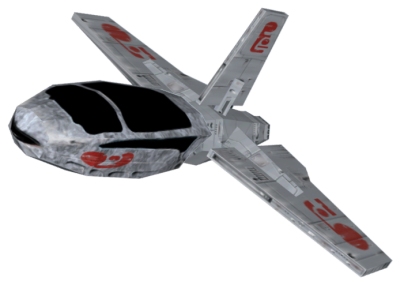
Capsule: Less maneuverable than the Z-95, vulnerable and only slightly faster than the Y-Wing.
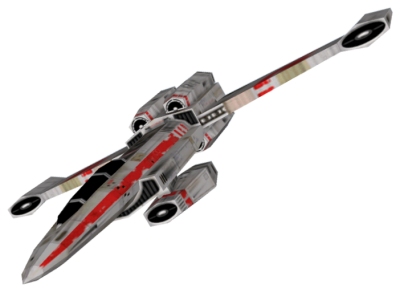
Capsule: Excellent speed, pitch and acceleration compensate for this large fighter's lack of roll and shielding.
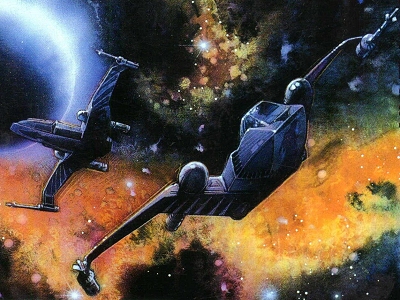
Concussion Missiles are equipped with their own shields. The Missile Launcher does not have shields but relies on the shields of the host ship if equipped.
“The concussion missile's armored tube carries the warhead, a guidance computer, and a propellant system. Exterior shield projectors wrap the missile in a protective energy shroud, giving it the appearance of an elongated laser cannon.”
— Bill Smith, “The Essential Guide to Weapons and Technology”,
page 78 (c. October 23, 1997) (emphasis added)
Fire Control: 2Dwas assigned based on the average of other concussion missile launchers translated in this thesis.
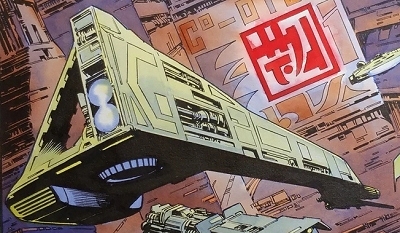
Capsule: Pursuer-class heavy patrol ship popular with Mandalorian police units because of its toughness and adequate cargo space for police duties.
The X-Wing Alliance PC game sized the Pursuer-class similar to a large starfighter, 21.83 meters long in spite of the flavor text claiming adequate cargo space for police duties
. West End Games sized the ship significantly larger, 30.1 meters long to fill the role of police patrol craft and to allow for specialized prison cells installed by Boba Fett.
Due to the slender design, the awkward placement of the cockpit, at the zenith of the ship, over the main engines, and behind the forward-facing twin blaster cannons, we realized that even at 30.1 meters long the ship could not accommodate the room necessary for the crew to travel from the cockpit to the rest of the ship. Likewise there was insufficient room for all the equipment described in the sourcebooks and essential guides as well as other vital mechanical systems. We discovered an increase in size by +40% or 42.14 meters long resolved most sizing issues with the ship.
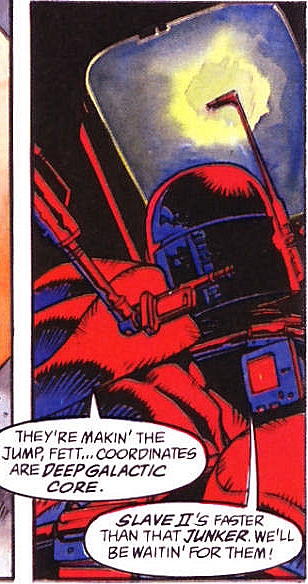
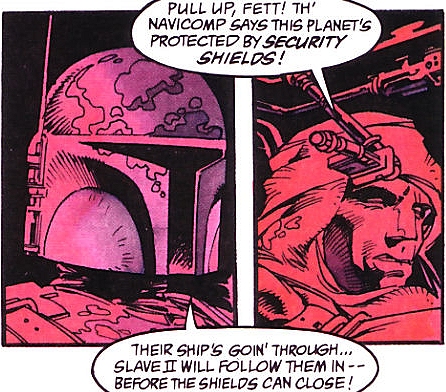


In “Dark Empire”, 4 of 6, aboard the Slave II, the bounty hunter Dengar, is clearly monitoring sensors and transmissions, sitting right behind Boba Fett.
“THEY'RE MAKIN' THE JUMP, FETT... COORDINATES ARE DEEP GALACTIC CORE.”
— Tom Veitch, “Dark Empire: Confrontation on the Smugglers' Moon”,
4 of 6, (c. June 23, 1992)
“PULL UP, FETT! TH' NAVICOMP SAYS THIS PLANET'S PROTECTED BY SECURITY SHIELDS!”
— Tom Veitch, “Dark Empire: Confrontation on the Smugglers' Moon”,
4 of 6, (c. June 23, 1992)
Does Dengar appear to only be a passenger or does he have a crew station with a terminal for sensors and communication functions?
The stats for the Slave II on pages 100-101 of the “Dark Empire Sourcebook” are Crew: 1
and for the single Ion Cannon Fire Arc: Turret
. The same stats are copied in the stock Pursuer-class Enforcement Ship on page 75 of “Pirates & Privateers”. It seems illogical for a police vessel equipped with two crew stations (see the three graphics from two sources to the right) to have a crew stat of just 1.
Likewise It seems unnecessary for turreted weapons to be fired by the pilot in this application. It makes more sense for the pilot to fire the forward-facing Blaster Cannons while the copilot serves as a secondary gunner to operate the turreted weapon on the ship to provide better peripheral protection. Optionally it is also possible there is a separate gun turret in a different part of the ship to operate the ion cannons on the stock model. For this reason the Pursuer-class will instead have a stat of Crew: 2 ( 1 can coordinate)
in this translation.
Taim & Bak KD-12-2: No manufacturer or model number was assigned to the Blaster Cannons on Slave II nor the Pursuer-class in any publication. Model number based on a higher output Taim & Bak Kd-3 Light Blaster Cannon (see Galaxy Guide 6, 2nd Ed, page 40 for more info). The -2
is indicative of the weapon system being twin-barreled and fire-linked.
Comar F-7t: No manufacturer or model number was assigned to the Ion Cannon on Slave II nor the Ion Cannons on the Pursuer-class in any publication. Model number based on performance stats somewhere between the Comar F-4, and Comar F-9 Ion Cannons (see Galaxy Guide 6, 2nd Ed, page 40 for more info). The t
is indicative of the weapon system being turreted.
Sienar Fleet Systems M-g-1: Based on the Assault Gunboat SFS M-s-3 (Missile Launcher Standard Model 3) we interpreted the model to SFS M-g-1 (Missile Launcher General-purpose Model 1).
Heavy Weapons — Starfighter Scalechart published in the “Star Wars® Gamemaster Kit”. The mistake was found by former West End Games® employee Todd Quigley who also discovered the error was copied into the second edition rules. In an interview, Todd Quigley corrected the long range stat to 14 units in space, and 1.4 km in atmosphere.
popular with Mandalorian police units because of its toughness and adequate cargo space for police duties, there is a need by some constabularies to apprehend criminals and pirates. Logically these craft would come equipped with a hardpoint and necessary wire harnesses to install a compact Tractor Beam or any compatible beam weapon to this end.

Capsule: Multi-role fighter. Similar to the Z-95 Headhunter, but with slightly better performance.
Sienar Fleet Systems M-g-1.1: No manufacturer or model number was assigned to the General-purpose Missile Launcher on the Missile Boat. Model number based on a higher capacity Sienar Fleet Systems M-s-3 (Missile Launcher Standard Model 3) with an ammo bay with a capacity of 4/3/2/1 (Missile Launcher General-purpose Model 1, 1 ammo bay).
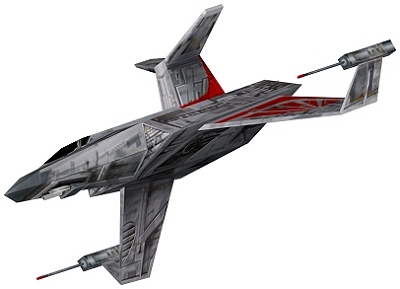
Capsule: The last model starfighter to roll off the assembly lines of S/SS before Alderaanb was destroyed. Not quite up to the performance of an X-Wing.
Dymek HG-4: No manufacturer or model number was assigned to the General-purpose Missile Launcher on the Razor Fighter. Model number based on a higher capacity Sienar Fleet Systems M-s-3 and the Dymek HM-6 with an ammo bay with a capacity of 4/3/2/1. It was also assumed an Alderaanian manufacturer would not use an imperial company but a corporation (Dymek) friendly to the Rebel Alliance.
“No! Alderaan is peaceful. We have no weapons. You can't possibly...”
— Princess Leia Organa, “Star Wars® (A New Hope)”,
(c. May 25, 1977) (emphasis added)
Due to the above quote it is assumed the Starypan/SunHui Spaceworks Corporation was headquartered on Alderaan but the actual manufacture of the starfighter was conducted off planet due to Alderaan's strict environmental and pacifist policies. The destruction of Alderaan and its corporate headquarters, spelled the death of the Starypan/SunHui Spaceworks and it is suspected surviving blueprints, technical manuals, and schematics survived off planet to provide aftermarket production of knockoff fighters and spare parts.
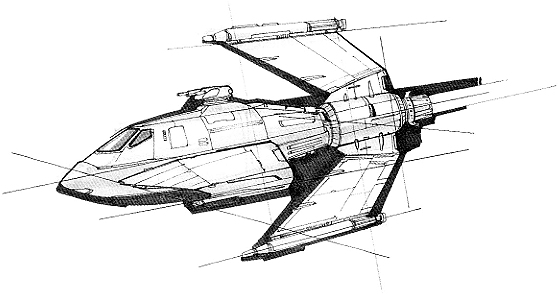
Capsule: Defense/patrol blastboat. Primarily used as a patrol or assault gunship, serving well on fleet point missions with or without support.
“The blastboat is considered a capital ship not because of its size, but because of its mission profile. It also has the armament to take on smaller capital ships.”
— Bill Slavicsek, “Heir to the Empire Sourcebook”, page 139 (c. July 1992),
“The Thrawn Trilogy Sourcebook”, page 239 (c. April 15, 1996)
The scale of this ship is listed as Scale: Capital (due to power output)
. With the exception of “Pirates & Privateers”, page 86, references to skills related to the ship are: Skill: Starfighter piloting: Skipray Blastboat
, Starship Shields
, and Starship Gunnery
, of which all are Starfighter-scale skills. The only Capital-scale skill listed on this ship's stats are for its Medium Ion Cannons Skill: Capital ship gunnery
. For the purposes of this translation, this ship will be treated as Starfighter-Scale and the capital-scale Ion Cannon will be labeled Scale: Capital
.
The first appearance of Second Edition stats, with weapon ranges, for the Skipray Blastboat were in “Planets of the Galaxy”, Volume 3, page 14 (c. September 1993), the Greetbos. The Ion Cannon Ranges in this publication were incorrect using the ranges for a Starfighter-scale Laser Cannon instead of a Capital-scale Ion Cannon.
The incorrect ranges were copied in the following publications:
The correct Capital-scale Ion Cannon ranges will be used in this translation.
50KMin error. When compared to the rest of the chart,
100KMis the correct value and appears in the stats of this ship.
Sienar Fleet Systems Tt-s-1.6 No manufacturer or model number was assigned to the Proton Torpedo Tube on the Skipray Blastboat. Model number based on the Sienar Fleet Systems M-s-3.
Sienar Fleet Systems Mt-s-1.3 No manufacturer or model number was assigned to the Proton Torpedo Tube on the Skipray Blastboat. Model number based on the Sienar Fleet Systems M-s-3.
The translation of PC game assets into RPG stats will invariably require revised and expanded rules to introduce these new elements to the game. Below are these elements.
| Space: | 1 - 3 su / 9 su / 18 su |
| Near Atmosphere: | 2 – 6 km / 18 km / 36 km |
| Atmosphere: | 100 – 300 m / 900 m / 1.8 km |